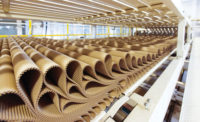Automation
4 Steps to Start Using OEE Today
Make your packaging or manufacturing line efficient by adopting overall equipment effectiveness.




As packaging lines have become more efficient, waste or problems on the line can become less visible and harder to identify. For example, lines might be slow due to multiple micro-stops, or overall line performance might falter due to lack of standard work or process for operators. We can miss what we don’t see.
But there are solutions available that allow line managers to better see and correct problems. Overall Equipment Effectiveness (OEE), a Lean manufacturing principle that measures the productivity of a line, shift or piece of equipment over a given timeframe, is one such solution.
Line managers who look to increase overall efficiency should consider adopting OEE because it helps reduce the six big losses of manufacturing (discussed below). OEE gives line managers data from across an operation. Having access to that data can mean the difference between a line that works efficiently and one that doesn’t.
In addition to implementing OEE, line managers should also implement and understand Total Productive Maintenance (TPM) and Single-Minute Exchange of Die (SMED), which is also detailed below.
First, let’s break down what OEE itself is.
What Is OEE?
OEE identifies the amount of time that is truly productive. It measures quality, performance and availability. There’s a bit of math behind it, but it is pretty straightforward. Your OEE percentage is the percentage of your equipment’s availability multiplied by performance and quality. It looks like this in an equation:
OEE = Availability Factor x Performance Factor x Quality Factor
For example: If a packaging line can produce a unit in 30 seconds and I’m operating the line for an hour, I should have 120 units by the end of that hour. If I’ve only produced 100 units at the end of that hour, my line has suffered a performance loss somewhere.
By using OEE you’ll be able to see what went wrong, where that loss occurred and why you produced 20 fewer units than you should have. And you’ll be able to introduce countermeasures to reduce inefficiencies.
What Is TPM?
TPM is a philosophy around how you should be monitoring and working toward eliminating the six big losses, or the most common causes of equipment failure. They are:
- Equipment failure
- Setup and adjustment
- Idling and minor stops
- Reduced speed
- Process defects
- Reduced yield
By identifying, monitoring and working to eliminate these, you’ll be doing what it takes to keep unplanned — and unproductive — downtime on your line to a minimum.
What Is SMED?
SMED was originally created by Toyota when it began producing automobiles. Toyota had these big production dies that took a long time to change out. They were metal, bulky backbreakers attached to four-ton presses. Needless to say, changing these dies was time consuming. So the company wanted to know how it could reduce time spent on the die changeover in order to produce cars more quickly.
Since its creation, SMED has been broadened across the manufacturing industry to represent anything to do with line changeover. If I’m changing a line from 1-liter bottles to 2-liter bottles, for instance, there’s a lot I need to do: change the bottles, change the guides in my conveyer and change the height and positioning of the coding equipment. SMED encompasses anything you do to enable the changeover to run smoothly.
How to Start Using OEE:
Now that you understand the terminology used surrounding OEE, I believe you will want to reap the benefits by implementing OEE in your plant. I recommend four ways to start the transformation:
- Start small — Pick a single area first. Test the OEE system on something small (such as a single packaging line). You’ll want to start small because that will allow you to compare multiple areas once you begin using OEE across operations. If you can prove success on the line where you implemented OEE, you can get some quick wins that can help the decision-makers in your organization see why they should buy into using it across the plant.
- Identify metrics to use — Once you’ve selected the OEE/TPM framework, you’ll need to select the most appropriate metrics to use in order to get the most productivity out of that framework. Sure, you’re measuring availability, productivity and quality, but there’s a lot of freedom under those measurements to define what constitutes planned worktime or unplanned worktime. Any changes will affect your entire formula, so identify your metrics carefully. These metrics need to be planned from the start and stay consistent all the way through for the best use of OEE.
What’s the ideal rate of production in your line? To find out, consider installing sensors and connecting your printer to the IIoT (industrial internet of things), as well as to a data management solution in order to measure how your line operates, both piece-by-piece and as a unit. But no matter what you do, be sure that you stay consistent in measuring your metrics. Unequal measurement will yield uneven results. - Measure with an impact-versus-difficulty matrix — This is a simple, two-by-two graph on an axis. It measures difficulty from easy to hard on one axis and impact from small to large on another, essentially helping you prioritize which projects will have the most impact. For example, you’ll want to do many large and easy projects first and hold off on the smaller, but more difficult, projects. The impact-versus-difficulty matrix will help you visualize which projects are which. Any project lying in the middle of this matrix is where you’ll need to do some thinking: Is this project worth my time? Is it absolutely necessary? Using the matrix, you’ll identify which projects can be addressed quickly.
- Define clear roles and responsibilities — In OEE, every task needs to have an assigned owner. Frameworks don’t make decisions, people do. Even if the owner of that task doesn’t do the work themselves, he or she will be the one to ensure the task is completed. Decision-making will need to be swift; by making one person the owner, you’ll help ensure that actions are being taken immediately to rectify any issues with the line.
Hopefully, you now have a better idea of what OEE can do for your packaging lines. In my years with Videojet, I have seen OEE turn lines from unproductive to more efficient, thus, decreasing the expenditures in the company’s budget.
By starting small, identifying key metrics, measuring your OEE/TPM framework with an impact-versus-difficulty matrix and defining clear roles and responsibilities for each task, you will be well on your way to more efficient packaging lines.
OEE isn’t a system of miracles, but a system of diligence. However, once installed the benefits are great: By using the data that OEE provides, you can help to more accurately predict any slips, breaks or hours of downtime before they happen and take swift corrective action if they do.
Fred Susi is the vice president, Global Services, Supplies and Cloud-Based Solutions at Videojet Technologies, where he’s held several senior leadership roles within product management. Prior to his experience at Videojet, Susi held roles in product management, finance and service with Zebra Technologies, Dresser Wayne and Suntronic. He holds an MBA from University of Illinois at Chicago and a BS in Biophysics from University of Illinois-Champaign.
|
OEE Tracker for Improved Efficiency on Pharmaceutical Packaging Lines Supply Chain Wizard (supplychainwizard.com), a leading full-service global consulting firm specializing in serialization and traceability, supply chain strategy and operational transformation programs, has introduced a user-friendly OEE Tracker — an analytics-based tool to improve the overall equipment efficiency of pharmaceutical packaging and manufacturing lines in a cost-effective, expedited manner.
The OEE Tracker measures and improves line efficiency by uncovering and honing line-specific best practices. The solution amounts to a business-bolstering way to utilize the vast amounts of data generated by systems necessary to stay compliant with modern-day regulations, especially those pertaining to serialization and aggregation. Eight predefined reports provide details of OEE performance, exceptions and root causes of discovered shortcomings, with “Live view” and “Historical view” dashboards highlighting issues and opportunities. The tracker also offers an advanced analytics package that supports scheduling optimization and “keep or buy” decisions for best asset replacement and predictive maintenance. |
Looking for a reprint of this article?
From high-res PDFs to custom plaques, order your copy today!








